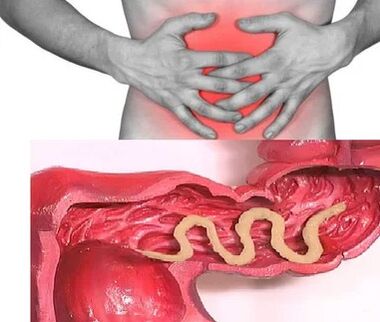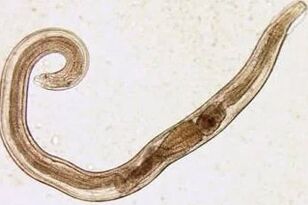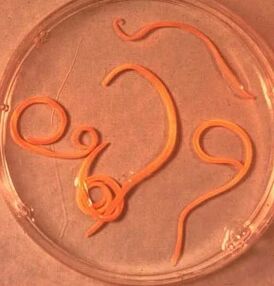To date, science is known about 280 types of worms that can develop and live in the human body, parasitize in various bodies and tissues.The frequency of human infection depends on the climatic and socio-economic conditions of certain territories (in underdeveloped countries, especially in those located in the tropical and subtropical zone, the level of parasitic infections is much higher than in economically developed countries).
Helminthim Helminhim Methods:
- Biogelmintosis (animal infection).
- Contagioine helminthose (transferred from person to person).
- GeoGelMintoses (diseases caused by parasites carried out by one of the vital cycles on Earth).

Factors influencing Helmintijas events
Method of penetrating parasite in the body:
- Degree of Helmint Adaptation on the human body;
- Population density (quantity) of parasitic individuals;
- The worm habitat (parasites of tissues live in the thickness of soft tissues and cleaning live in the gaps of hollow organs).Some chancellations in different phases have educational forms and fabrics.Larval and the development of the worm phase, as a rule, cause more pronounced pathological changes.
In the absence of re-infection, the number of adult parasites in the human body is not increasing.This feature distinguishes significantly by herminthic invasions from diseases caused by bacteria, viruses, fungi and simple organisms.
Worms on people: Symptoms
Helminthosis is a disease characterized by 2 stages of the course (acute, from two weeks to two months) and chronic (from a few months to a few years).
Symptoms of acute phase helminthiasis
The first signs of the disease can be manifested at different times (most often after 2-3 weeks, and ascaridosis-after 2-3 days, and with Filairiosis, the incubation period may last 6-18 months).
In the acute phase of the parasitic invasion, the most characteristic symptom is an allergic reaction (antibodies are generated for the antigens of the migration of parasite colors).Often itchy, it is prone to a recurrent course, a recurrent exchange rate increases, regional lymph nodes appear on the skin, and the appearance of generalized or local edema, muscles and joints may occur.Also, migrating parasite larvaes can cause chest pain, cough, choking, chair, nausea and vomiting.
At the same time, the acute phase of helmintis can be accompanied by more serious disruptions (heavy forms of pneumonia, hepatitis, allergic myocardis, hepatosterogalia (increasing liver and spleen).
The blood increases the amount of eosinophils (eosinophilia) and the normal quantitative ratio between protein fractions (Disproteinemia) is disturbed.

Chronic Helminthiasis signs
The symptoms of the chronic phase depend directly on which organ "inhabited" with parasites, as well as their size and quantity play an important role.
Thus, when the parasite in the intestines of individual individuals, the disease may occur asymptomatic (with the exception of infection cases with very large parasites).Characteristic characteristics of the chronic phase of intestinal hermiists are dispreceptic disorders.In children, acenoarotics syndrome and pain is more pronounced.With the mass invasion of Aparida, the obstruction of intestinal, mechanical jaundice and pancreatitis is possible.
By consuming all the substances needed for their vital activity from the host body, helminths causes digestive disorders, violations of vitamin, minerals, carbohydrates, proteins and fats.At the same time, products of life worms inhibit normal intestinal microflor and reduce the immune body forces.
In people suffering from Helminthias, due to weakened immunity and improved cell division process (the consequences of permanent parasite reconstruction), the risk of malignant tumors increases significantly.
Types of Helminths parasites in the human body
Causal agents of human helmintis are 2 types of worms: round (nematodes) and flat (ribbons and plates).
Round worms
Pinworm
Parasites that are the cause of enterobioza small (up to 10 mm) thin cavities worms that have grayish-white dyeing.The infection occurs in a tireless way (through the mouth).The reason for that is dirty hands.Parasite eggs can be in the ground, on wool of infected animals, unwashed vegetables and fruits, etc.At the same time, with enterobiosis, cases of self-extracting (especially in children) that occur as a result of combed eggs and the next branch eggs are not unusual.Larve cuts within two weeks in the digestive tract.Converting in an adult individual, the worm is parasitized in the lower parts of small and upper parts of thick parts of parts.

Askarida
Askaride is a large parasite of red-yellow-shaped spindle, reaching the condition of 40 cm (females) and 15-25 cm (males).Without suction cups or other attachment devices, Ascaride can be moved independently according to food masses.The eggs set from the female parasite differ with feces.
Acadosis Infection occurs in the event of swallowing of mature eggs along with water or unwashed vegetables and fruits where there are soil particles.After the eggs penetrate the guts, mature larvae comes out of them.Then, the introduction into the intestinal wall, reach the heart in accordance with the blood, and from there are falling into the lungs.Through the lung alveoli, the Lyga ascarida through the respiratory tract penetrates again in oral cavity.After the repeat swallowing, the parasite reaches the small intestine, where it develops into an adult.The worm lives 12 months and then dies and stands out with feces.In the hips of one owner can live one or a few hundred individuals.
Vlashev
Vlasov, a trichopophalosis agent, is a white prisoner that is parasiced in the initial part of the large intestine and reaches 4-5 cm.The parasite feeds on blood and tissues of rectal mucosa.
Eggs that previously overdue by women on the gut walls come out together with feces.Their development occurs in the environment (optimal in the soil).Eggs with parasitic characters are penetrated into the body with a touch, through dirty hands, water or unwashed vegetables and fruits.

Trichinella
Causal Trichinelosis Agent is a small round herminth that reaches 2-5 mm in length.The infection occurs when the use of low fried meat (pork, bears Dubica, wild pigs).The penetration in the intestine, parasite larvae in 3-4 days is matured to the state of a sexually ripe individual.The expected lifespan of the worm is 40 days, after which the parasite dies.Driving at the intestinal wall, the larvae penetrates the bloodstream and is carried in all the human body organs, placing in the muscles.In this case, the most commonly affected respiratory and facial muscles, as well as muscle-ado-bending limbs.
In the first days after invasion, patients complain about abdominal pain.Then, after about two weeks, the body temperature is growing at 39-40 s, itching on the skin appears on the skin, muscle develops, and facial swelling.During this period, in case of mass infection, there is a significant risk of death.After about a month, recovery occurs.The parasite is capsulated in spiral form, after which it dies within two years.
Ankilostoma and Ne -core
These two parasites are similar to each other with biological characteristics, as well as in caused diseases.This is usual to unite them under the general name (Ankilostoma).The worms reach a length of 10-15 mm are parasiled in 12-p.Hose.It should be noted that this is one of the most common, but at the same time rarely identified parasites.Worm worms penetrate the human body through the skin when they are in contact with infected soil.Furthermore, entering the bloodstream, they, just like ascarides, migrate to the lungs, and then, through bronchi, along with a crowded sputum - to the digestive tract.Anquilostoma is parasitized in the intestines, which are fastened to the intestinal wall.The parasite that eats exclusively blood bite the blood vessel by piercing the mucous membrane, injecting an anti-stream-vampring component.During the day, an adult can absorb 0.05-0.35 ml of blood on average.Therefore, the most characteristic symptom of this helminthiasis is anemia's lack of iron, as well as change compared to protein fractions (Disproteinemia).
Flat worms
Wide strip
This is one of the largest helicotics reaching a length of 10-20 meters.The disease caused by this parasite is called dipylobotrioosis.The worm development cycle begins with freshwater fish or crabs.Leečica enters the human body, and that is the ultimate owner of a wide ribbon with caviar or infected fish fillet.Reaching a small intestine, the parasite is attached to his wall and is growing on a sexually mature individual.
Liver bacon
The parasite that causes a desisthorchiasis is a flat worm that reaches a length of 7-20 mm.It should be noted that more than 50% of the cases of liver cubes (it is also called the Bikomomat Cat) fall on the inhabitants of Russia.The parasites lasts begin to develop after the eggs fall into sweet water (from snail swallows).Then penetrate the body of the fish (carp, crushed carp, Bream, Roach).Human infection arises when eating infected fish flesh that has not passed enough heat treatment.The larva of the liver bombs from the small intestine penetrates the biliary channels and into the gallbladder, there firming with two suction cups.
Taurus and pork
These parasites almost identical in the structure reach a length of 5-6 meters.The infection with Tusinhinhosis and the Tucijas occurs due to the use of cattle or pork infected Finns (one of the middle forms of Helminthize).Visible Finns, presented in the form of whip bubbles, reaching 0.5 cm size, are attached to the person's small bowel wall and turn into an adult in 3 months.The comic parasite, which consists of more than 2,000 segments, is constantly growing.At the same time, the ultimate segments that contain eggs come and range independently along the colon to an anal opening, then pull out of anal or exposure to the external environment along with feces.The most characteristic symptoms of helminthiasis is a violation of the digestive tract.
Echinokoccus
This parasite person is a middle host.The worm is parasitized in the human body in the form of Finn.The final owner of echinococcu is a wolf, a dog or cat.The infection occurs in a tireless way in contact with animals and environmental cases, with a fist of echinococcods.After the intake of intestines, onkosphere (six-false larvaes) are developing from them.From the hose penetrates the bloodstream and worn throughout the body.
Alveokokk
This parasite, which is considered a variety of echinococcus, one of the most dangerous helmintiases (alveococos), which is similar to the seriousness with cirrhosis and liver cancer and liver cancer.The infection appears with the penetration of nancifu (eggs with mature larvas) into the intestines.There, the embryo comes out of the egg and, introducing to the intestinal walls, penetrates the bloodstream.Furthermore, with blood flow, the parasite spreads through all the tissues and bodies of the body (most often localized in the liver).There is that the main phase of development begins in Lacin (Multi -hahva bubble, laurelocyst) is formed).Each chamber contains the Embry head of the parasite, which is still gradually developing.Lavrocists are very aggressive formations that are constantly growing due to increasing bubbles, as well as have the possibility of germination in the liver, such as cancer metastases.
Helminthiasis diagnosis
The diagnosis of herminthic invasions includes the following events:
- Basic billing of anamnesis that helps to find out possible causes of infection;
- Laboratory stations of feces, blood, content 12P hoses, rectal and perianal mucus, muscle tissue, pulmonary evaporation, Žučica.During the analysis, eggs, segments or fragments of parasites can be detected during the analysis.At the same time, the increased contents of the eosinophil in the blood is also a signal of the presence of helminthiasis.
- In the diagnosis of diseases caused by larably phases or tissue parasites, serological studies (ELISH, RSC, indirect agglutination, immunofluorescent analysis, etc.).
- To identify Helminths that affect liver tissue, ultrasound, ct and endoscopic studies.
Worms on people: treatment
In the acute phase of the parasitic infection, the patient prescribes detoxification and desensitization of therapy.In severe disease (liver trehatosis, trichinosis), glucocorticoids are used according to medical indications.
As a medicine of a certain therapy, taking into account the nature of pathogens, a special anthelmontic hemotrapeutic agency are prescribed.
In parallel, the patient is recommended to take antihistamine and enterorbent.The final phase of treatment includes the use of probiotics that normalize intestinal microflor.
The special food saver is also prescribed (food should be easily digestible and contain little fat).
During the period of anthelmintical therapy, the patient needs a strict adherence to personal hygiene (in order to avoid re-infection).At the same time, with many Helmintia, all family members and people who are infected in constant contacts should pass treatment.





















